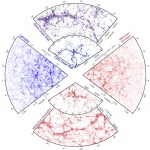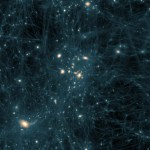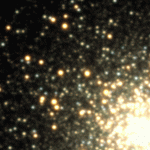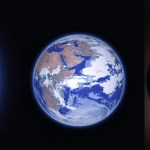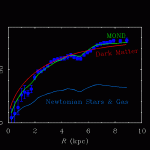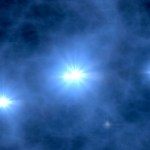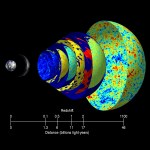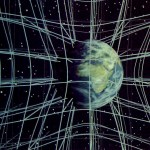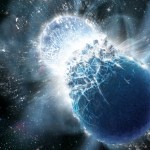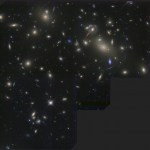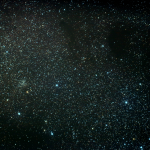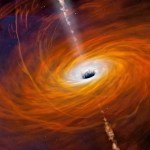ask Ethan
“First, you should check out my house. It’s, like, kinda lame, but way less lame than, like, your house.” -Lumpy Space Princess, Adventure Time
When you visualize our Universe today, you probably think about the great clumps of matter -- planets, stars, galaxies and clusters -- separated by huge distances. But on the largest of all scales, tens of billions of light years in diameter, any given region of the Universe is virtually indistinguishable from any other.
Image credit: ESA/Herschel/SPIRE/HerMEs, of the Lockman Hole.
But this structured Universe only came about because our Universe…
“All enterprises that are entered into with indiscreet zeal may be pursued with great vigor at first, but are sure to collapse in the end.” -Tacitus
If you want to form a structure like a planet, star or black hole, you need a large amount of mass together in one place. The way to bring that mass together, of course, is through the force of gravity, which attracts everything with mass towards one another in this Universe.
Image credit: ESO/VPHAS+ team, via http://www.eso.org/public/images/eso1403a/.
So why, then, would the greatest source of mass in the Universe -- dark matter -- be…
“Youth is the gift of nature, but age is a work of art.” -Stanislaw Jerzy Lec
You've heard it said many times here: the Universe, since the Big Bang, is 13.8 billion years old. But how do we know this to be true?
Image credit: Bock et al. (2006, astro-ph/0604101); modifications by me.
Moreover, how many different lines of evidence do we have that leads us to this conclusion? Is it like it is for dark matter, where we have a whole slew of them? Or are there only one or two different things we can look at in order to know?
Image credit: Joel D. Hartman, Princeton University, viahttp://www.…
“As the blackness of the night recedes so does the nadir of yesterday. The child I am forgets so quickly.” -Sylvia Ashton-Warner
While the night sky is littered with thousands of points of light -- the stars visible to the naked eye -- we know that beyond what human perception can see, there are hundreds of billions of stars in our galaxy alone, and hundreds of billions of galaxies in the observable Universe. Yet every star that ever has shone or will shine will someday run out of fuel and die.
Image credit: NASA/ESA and The Hubble Heritage Team (AURA/STScI), via https://www.…
“What was scattered, gathers.
What was gathered, blows away.” -Heraclitus
When you're looking around in our Solar System, we've got the Sun at the center, the planets orbiting them, and then moons orbiting the planets in turn.
But why is that necessarily the limit? Couldn't we have "moonlets" or some other, smaller satellites orbiting the moons?
Image credit: Frank Hettick / Fine Art America, via http://fineartamerica.com/featured/jupiter-and-its-moon-lo-as-seen-fran….
It seems like there's no reason that shouldn't be the case, but yet we don't yet know of any in the Solar System. Is there…
“It’s hard to build models of inflation that don’t lead to a multiverse. It’s not impossible, so I think there’s still certainly research that needs to be done. But most models of inflation do lead to a multiverse, and evidence for inflation will be pushing us in the direction of taking [the idea of a] multiverse seriously.” -Alan Guth
You've heard the question asked before about controversial or new-style pieces of work, "But is it art?" Well, what about the scientific counterpart of that?
Image credit: Moonrunner Design, via http://news.nationalgeographic.com/news/2014/03/140318-multiverse…
“Revolutions are something you see only in retrospect.” -Alan Greenspan
If there's one thing you can be certain of when it comes to the fundamental, scientific truths of our Universe, it's this: someday, in the not too distant future, those truths will be superseded by more fundamental ones. And even those, quite likely, won't be the final truths, but just one step further along the line towards our understanding of reality.
Image credit: Philosophy of Cosmology / University of Oxford, via http://philosophy-of-cosmology.ox.ac.uk/cosmos.html.
Does this mean that we've necessarily got…
“I soon became convinced… that all the theorizing would be empty brain exercise and therefore a waste of time unless one first ascertained what the population of the universe really consists of.” -Fritz Zwicky
When we look out at the galaxies in the Universe, watching how they rotate, we find that the starlight we see is woefully insufficient to explain why the galaxies move as they do. In fact, even if we add in the gas, dust, and all the known matter, it doesn't add up.
Image credit: Stefania.deluca of Wikimedia Commons.
Normally, we talk about dark matter as the only viable solution,…
“I just think too many nice things have happened in string theory for it to be all wrong. Humans do not understand it very well, but I just don’t believe there is a big cosmic conspiracy that created this incredible thing that has nothing to do with the real world.” -Edward Witten
It's a difficult fact to accept: our two most fundamental theories that describe reality, General Relativity for gravitation and the Standard Model / Quantum Field Theory for the other three forces, are fundamentally incompatible with one another. When an electron moves through a double slit, for example, its…
“[I]f there were no light in the universe and therefore no creatures with eyes, we should never know it was dark. Dark would be without meaning.” -C.S. Lewis
The Universe had two periods where light was abundant, separated by the cosmic dark ages. The first came at the moment of the hot Big Bang, as the Universe was flooded with, among the matter, antimatter and everything else imaginable, a sea of high-energy photons, including a large amount of visible light. As the Universe expanded and cooled, eventually the cosmic microwave background was emitted, leaving behind the barely visible,…
“We are told to let our light shine, and if it does, we won’t need to tell anybody it does. Lighthouses don’t fire cannons to call attention to their shining- they just shine.” -Dwight L. Moody
When it comes to the farthest thing we can see in the Universe, that's the Cosmic Microwave Background, or the leftover glow from the Big Bang, emitted when the Universe was a mere 380,000 years old. But what, exactly, does this mean?
Image credit: ESA and the Planck Collaboration.
Does it mean that we're seeing the "edge" of the Universe? Does it mean that there's nothing to see, farther back…
“Never erase your past. It shapes who you are today and will help you to be the person you’ll be tomorrow.” -Ziad K. Abdelnour
But even moreso than the fact that we're shaped by our past, the Universe itself -- geometrically -- is shaped by its history and composition. You might imagine all sorts of possibilities for how the Universe could have been shaped: positively curved like a higher-dimensional sphere, negatively curved like a higher-dimensional saddle, folded back on itself like a donut/torus, or spatially flat on the largest scales, like a giant Cartesian grid.
Image credit:…
“A single tiny light creates a space where darkness cannot exist. The light vanquishes the darkness. Try as it might, the darkness cannot conquer the light.” -Donald L. Hicks
While it might seem like there are an endless supply of stars in the Universe, the process that powers each and every one requires fuel to burn. At some point -- even though it's far in the future -- that fuel will all be spent, and all we'll be left with are stellar corpses of various types.
Image credit: E. Siegel.
But the Universe is full of second chances, and opportunities to bring not only burned-out stars back…
“Silently, one by one, in the infinite meadows of heaven,
Blossomed the lovely stars, the forget-me-nots of the angels.” -Longfellow
The cosmic microwave background is a thing of beauty, as not only does its uniform, cold temperature reveal a hot, dense past that began with the hot Big Bang, but its fluctuations reveal a pattern of overdensities and underdensities in the very early stages of the Universe.
Image credit: NASA / WMAP science team, via http://map.gsfc.nasa.gov/mission/sgoals_parameters_spect.html.
It's fluctuations just like these that give rise to the stars, galaxies, groups…
“Light thinks it travels faster than anything but it is wrong. No matter how fast light travels, it finds the darkness has always got there first, and is waiting for it.” -Terry Pratchett
If you want, you can imagine back in the Universe to a time before it looked anything like ours did. Before there was life, before there were planets, galaxies, stars, or even neutral atoms. Yet going back even to those times, there was still light, and there were still photons.
Image credit: the Cosmic Microwave Background of Penzias and Wilson, via http://astro.kizix.org/decouverte-du-17-mars-2014-sur-le-…
“Some say the world will end in fire,
Some say in ice.
From what I’ve tasted of desire
I hold with those who favor fire.
But if it had to perish twice,
I think I know enough of hate
To say that for destruction ice
Is also great
And would suffice.” -Robert Frost
We've come to believe that we know the fate of the Universe: that dark energy will drive distant galaxies and clusters apart, leaving only the objects that are already gravitationally bound together intact.
Image credit: NASA/JPL-Caltech.
Through the use of type Ia supernovae as standard candles, we've been able to trace out the…
“Hope is not the conviction that something will turn out well but the certainty that something makes sense, regardless of how it turns out.” -Vaclav Havel
When you take a look at the planets in our Solar System, one of the most striking features about them is that they all orbit in almost exactly the same plane.
Image credit: Joseph Boyle of quora, via http://www.quora.com/How-close-are-the-planets-of-our-solar-system-to-b….
It didn't have to be this way, of course; you could imagine a scenario where the planets swarmed in a great, random sphere around our central star. After all, gravity…
“Nobody ever did, or ever will, escape the consequences of his choices.” -Alfred A. Montapert
You might not think of falling into a black hole as a choice, but in the case of this week's Ask Ethan, someone is choosing to explore exactly that!
Image credit: original unknown, retrieved from http://mondolithic.com/.
Imagine, if you will, taking a solid object that's completely outside of an event horizon, of choosing a very massive black hole with minuscule tidal forces at that location in space, and then just barely pushing a tiny piece of that object over to the other side of…
“If everything seems under control, you’re not going fast enough.” -Mario Andretti
One of the toughest things to wrap your mind around in the natural world is the idea of special relativity: the faster you move, the closer you get to the speed of light, the more difficult it becomes to increase your speed at all. While you might approach the speed of light arbitrarily and asymptotically, you'll never reach it.
Image credit: user Fx-1988 of deviantART.
And yet, we have the Universe, expanding all the time, where the expansion rate itself is even speeding up. You might wonder, then, if these…
“Try to imagine what it will be like to go to sleep and never wake up… now try to imagine what it was like to wake up having never gone to sleep.” -Alan Watts
Neutron star matter is the stuff of legends: it's the densest three-dimensional material to exist in our Universe. With a density some 10^22 times that of water, you might think that a tiny chunk of it would be incredible to possess.
Image credit: The Mighty Thor / Marvel Comics.
But would such a chunk be stable, or would something catastrophic happen if you took a dense group of neutrons out of a neutron star? And if a small amount…
